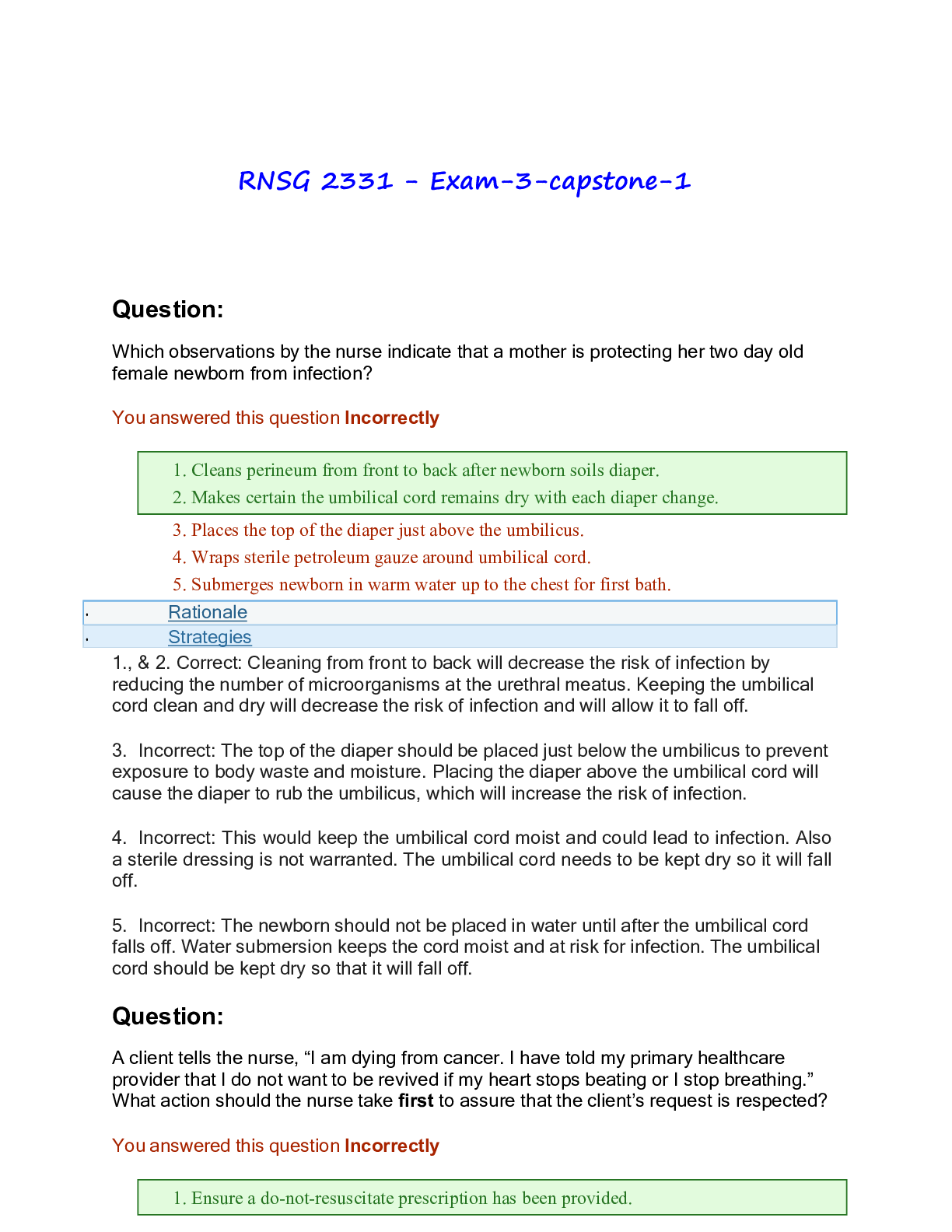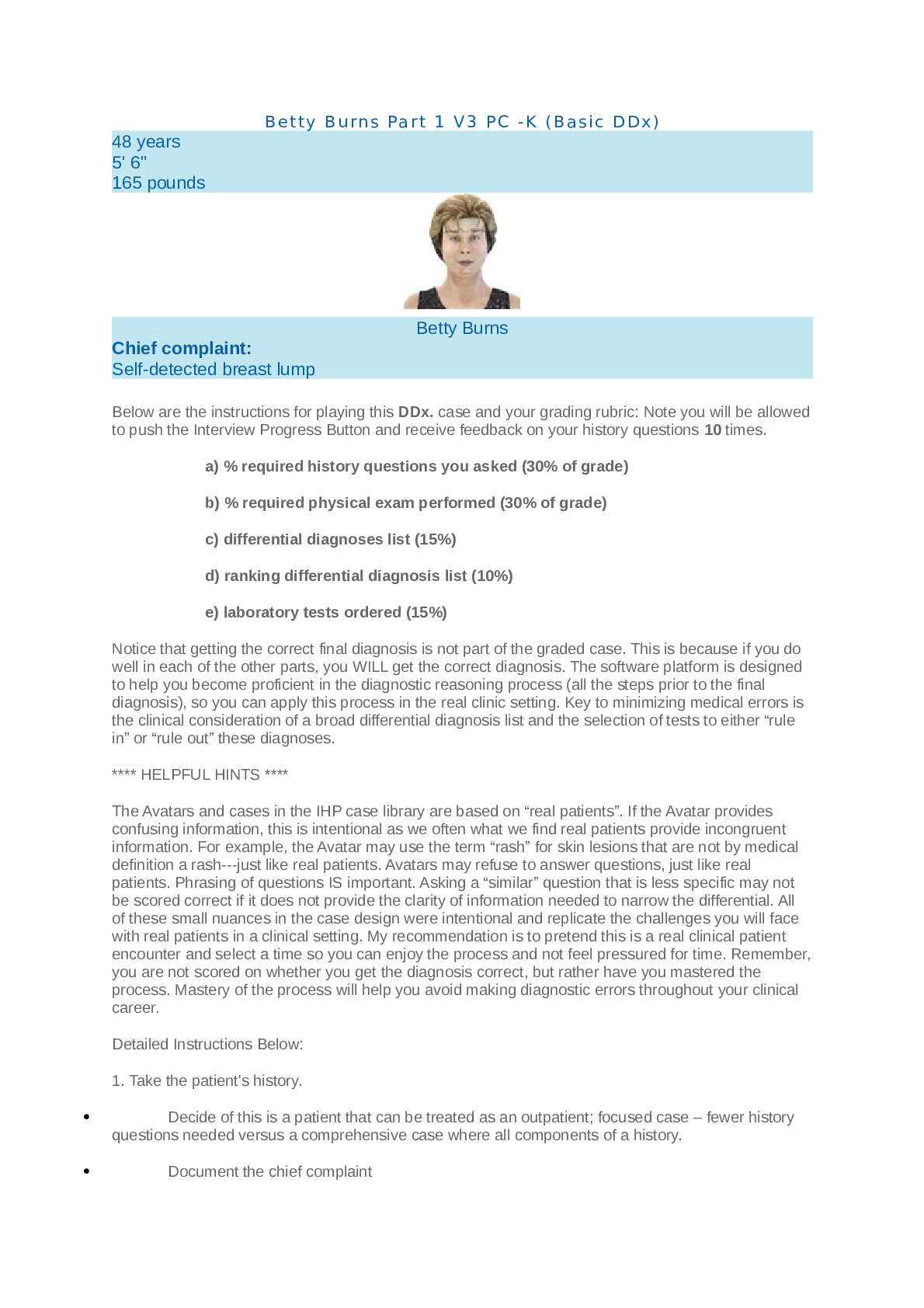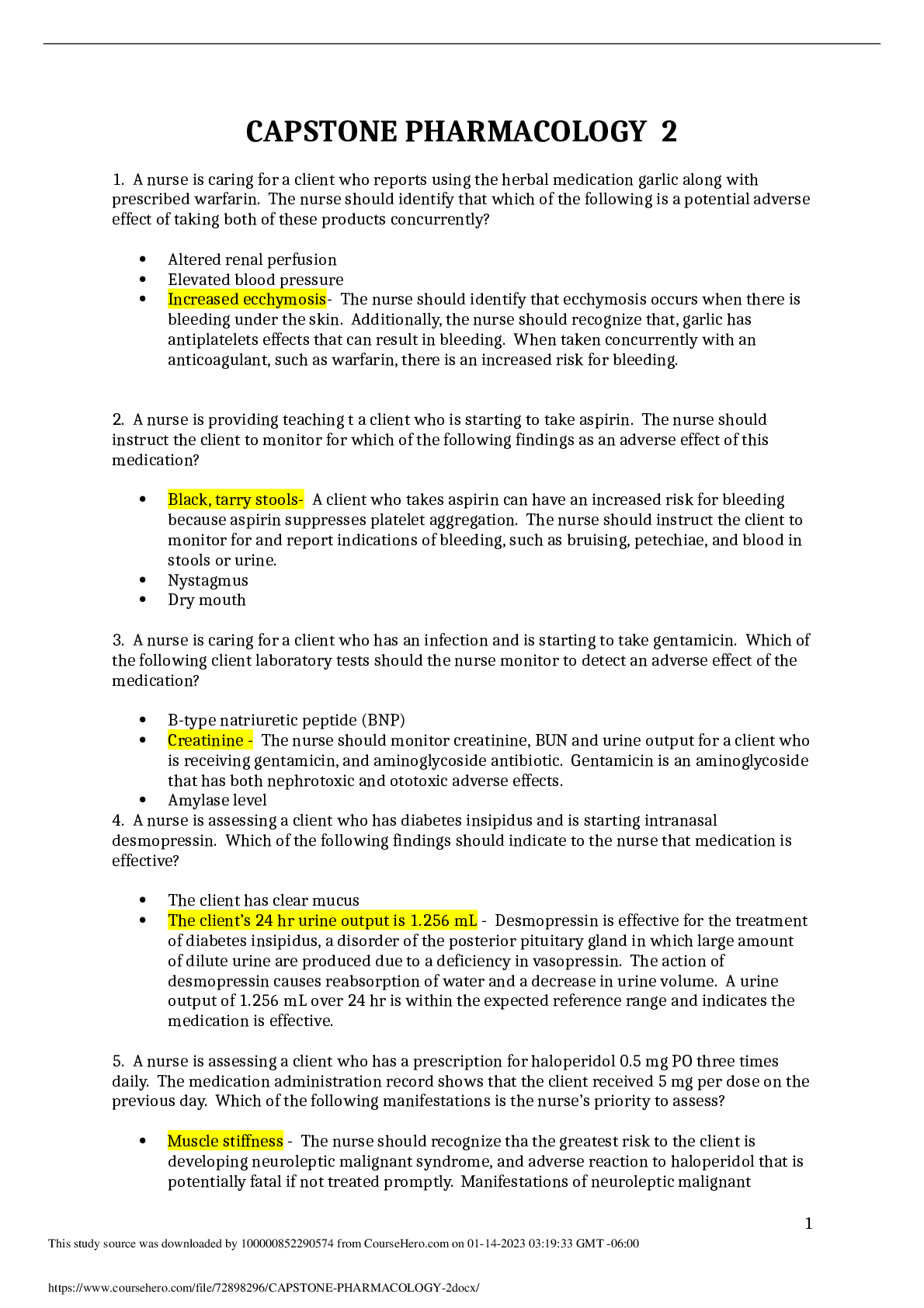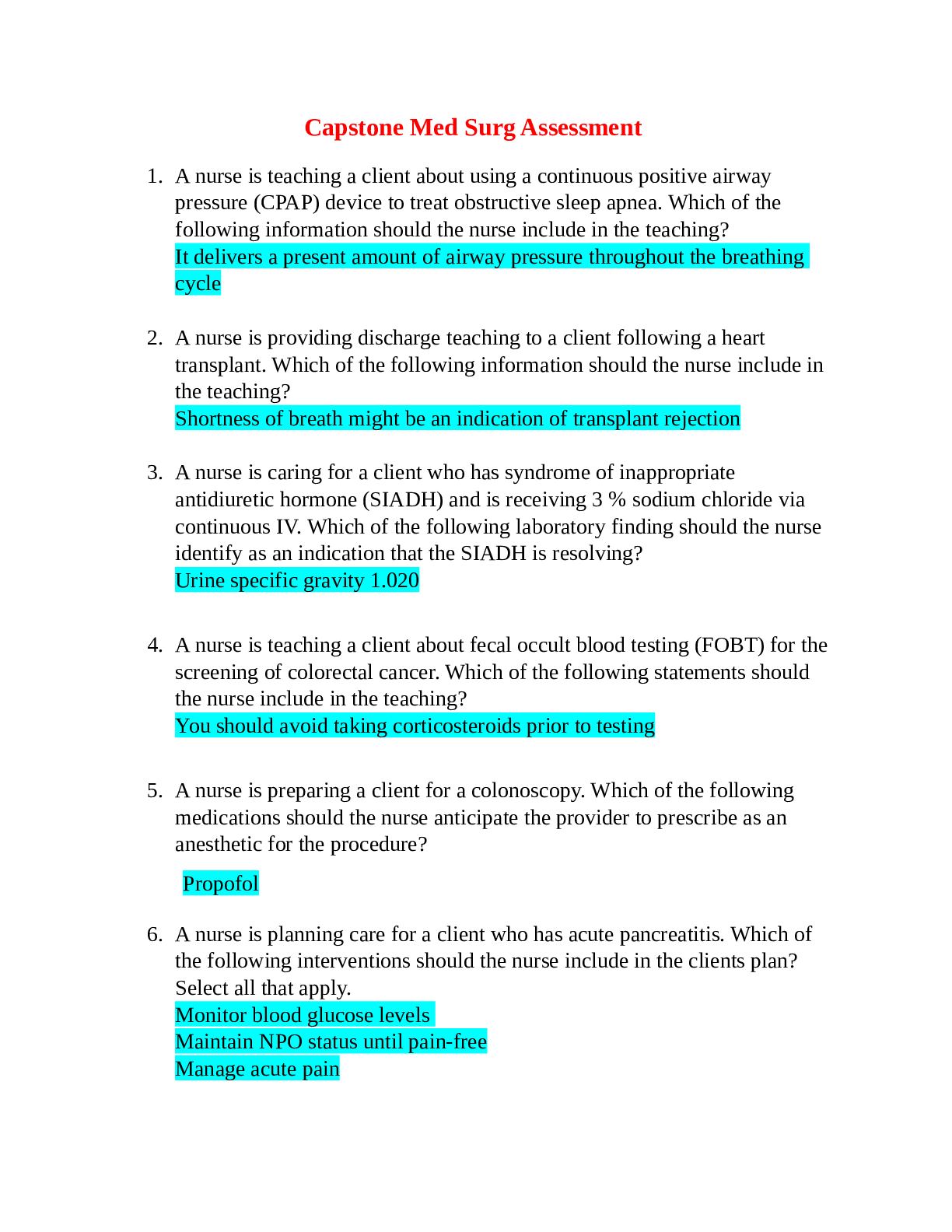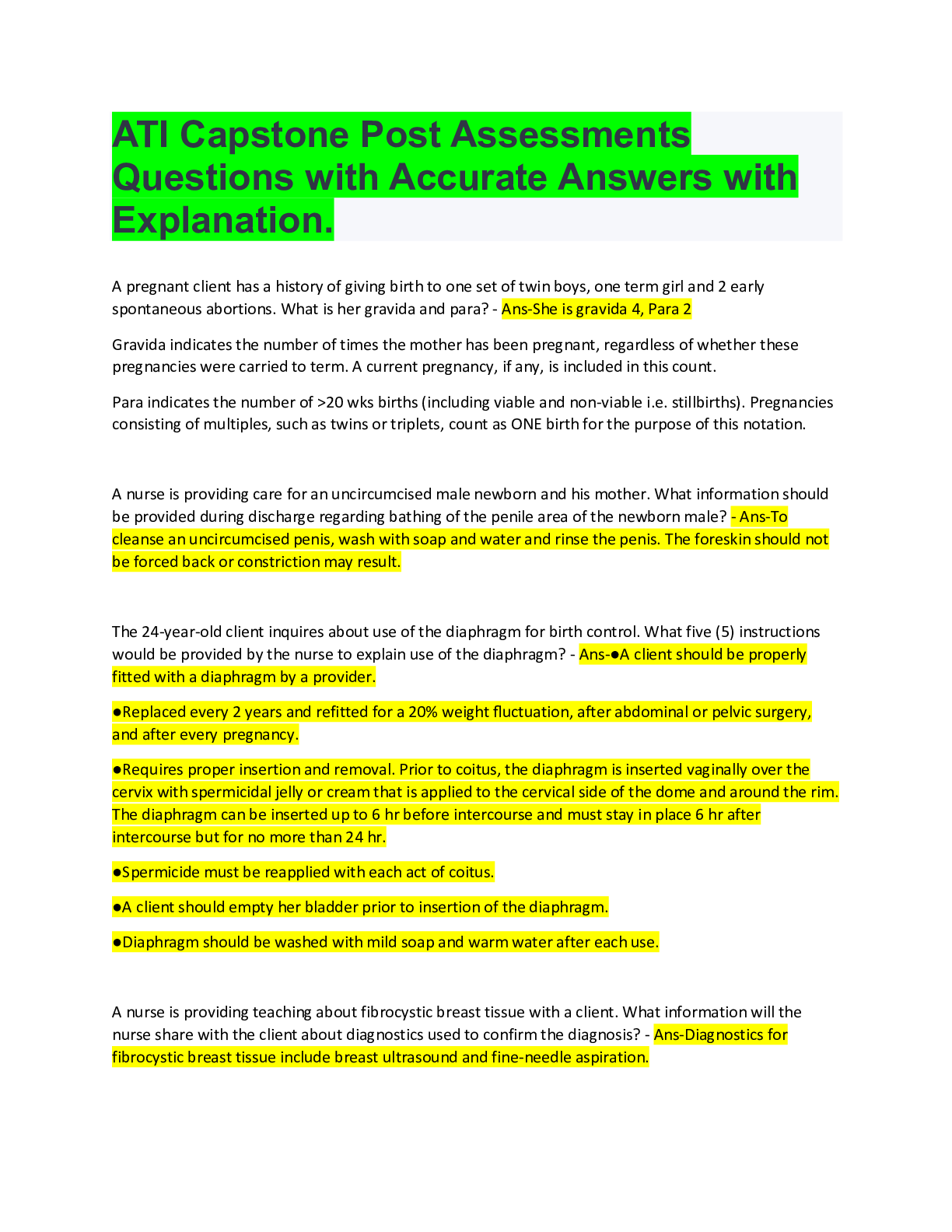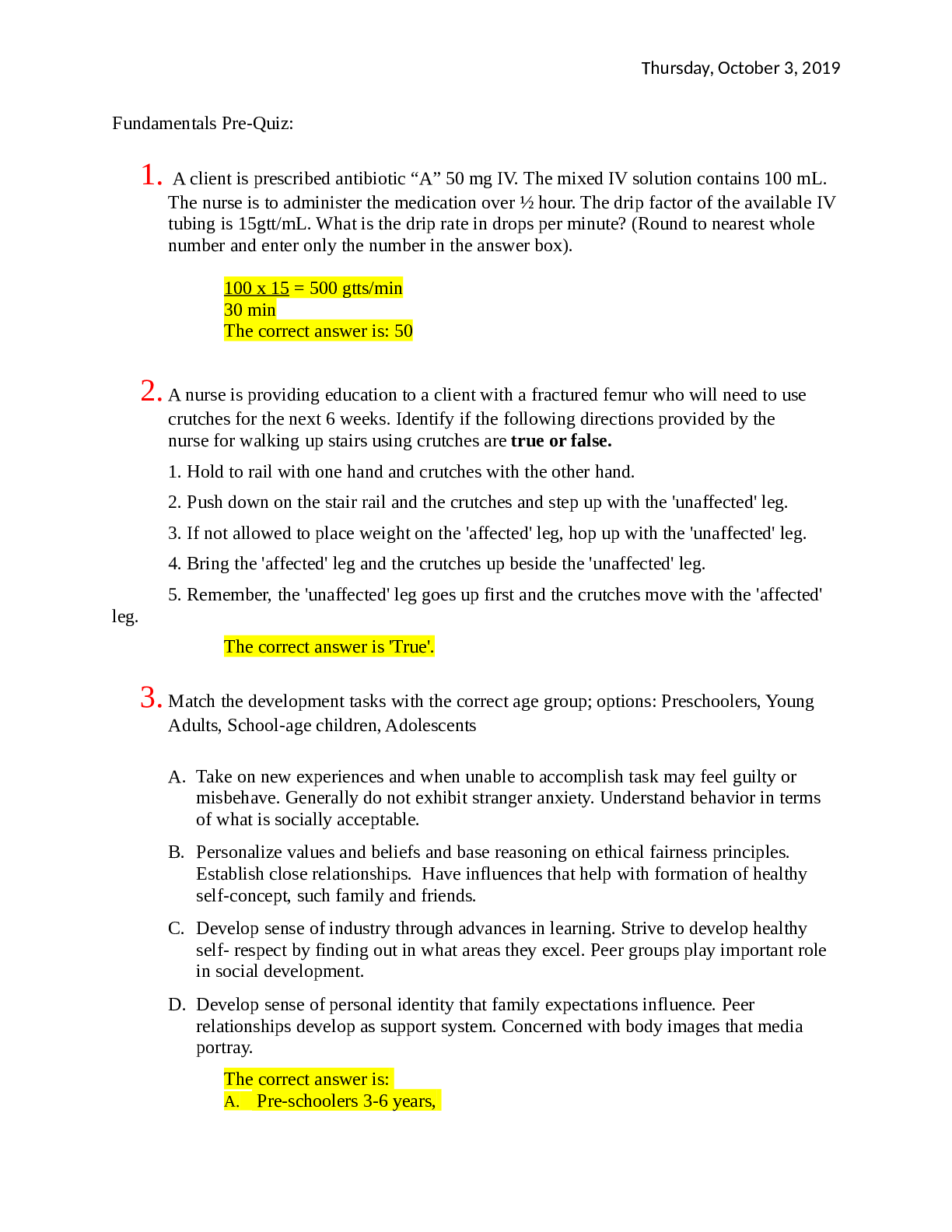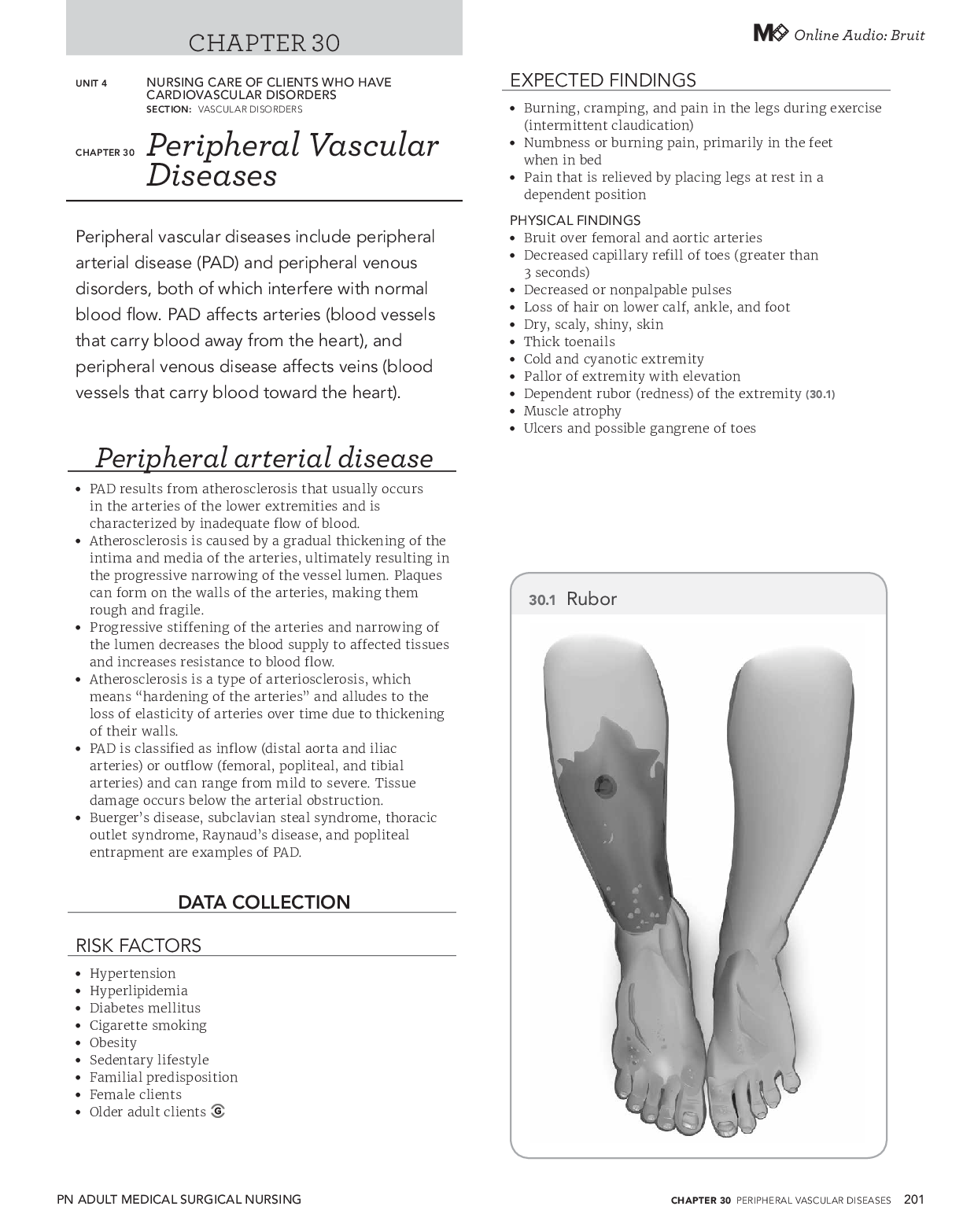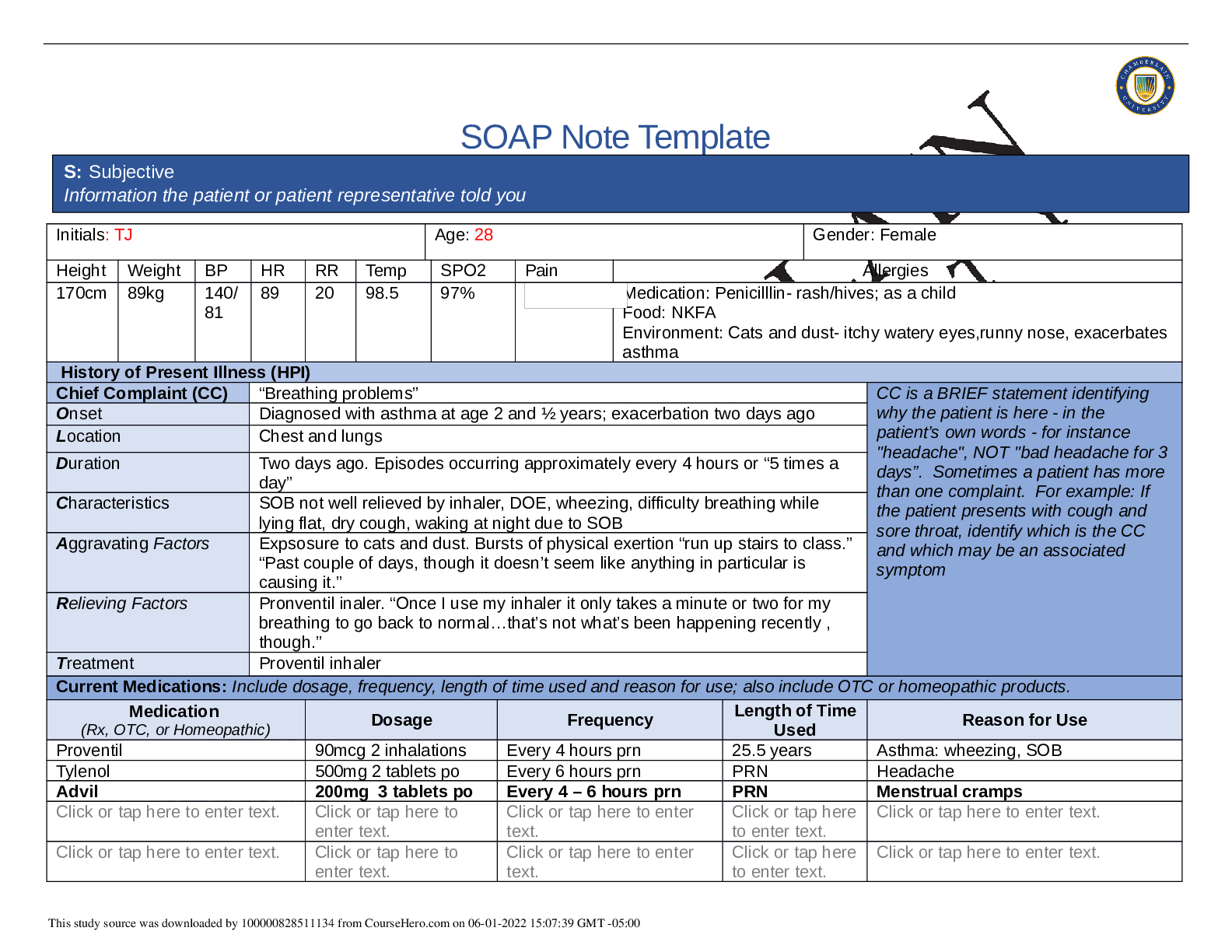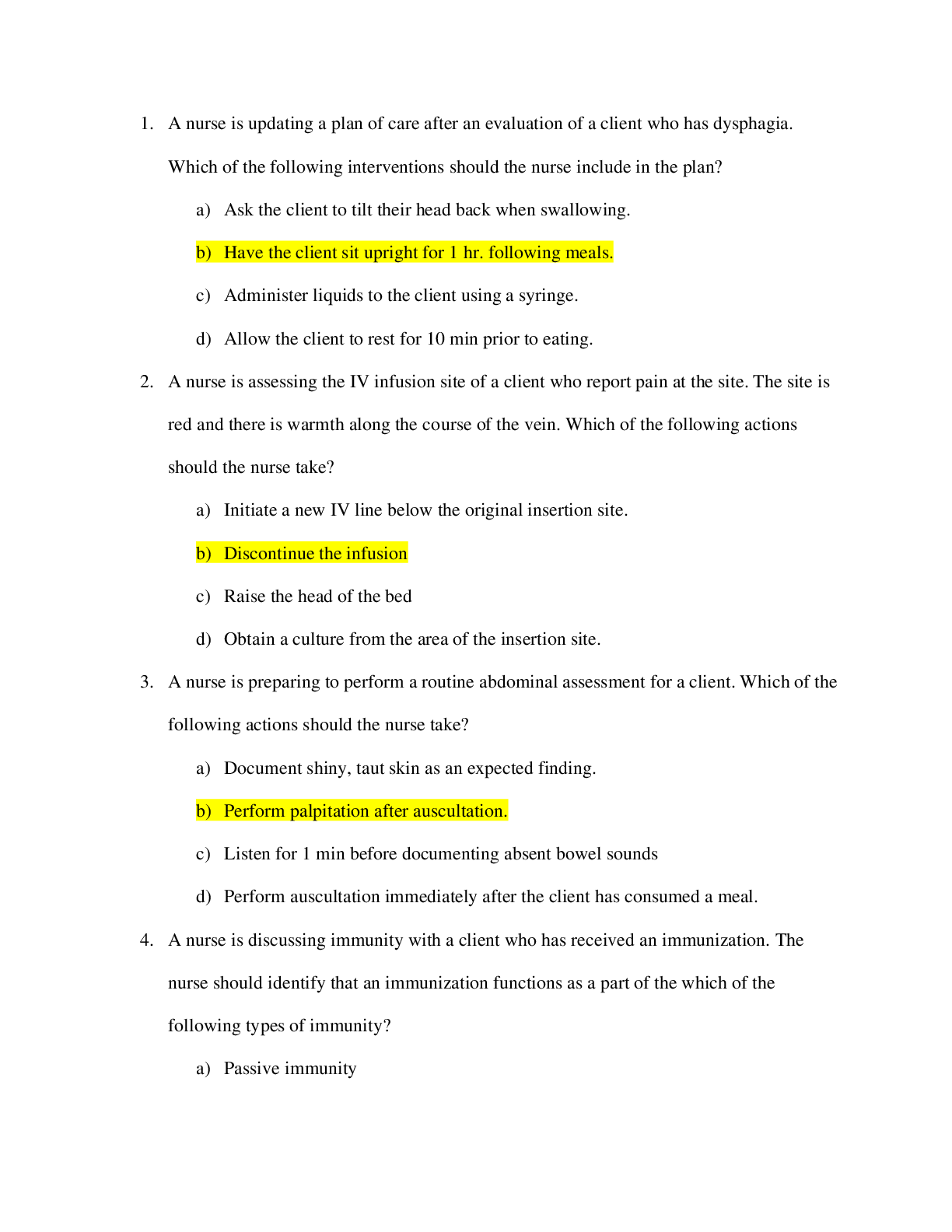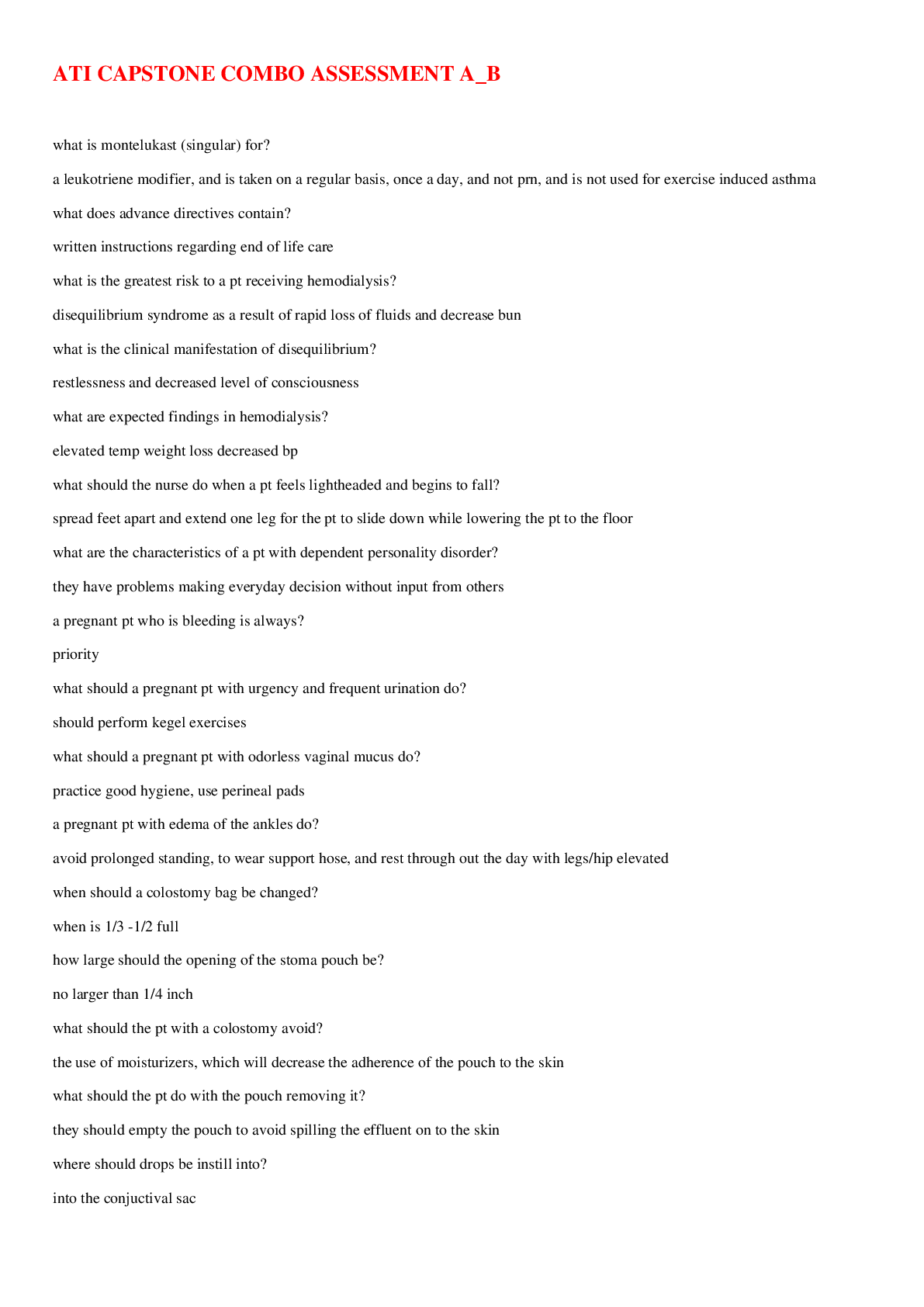*NURSING > CAPSTONE SIMULATION > (LATEST) NR 661 CAPSTONE PORTFOLIO CHAMBERLAIN UNIVERSITY OF NURSING (CAPSTONE__DR. LUNDE ASHLEY HAL (All)
(LATEST) NR 661 CAPSTONE PORTFOLIO CHAMBERLAIN UNIVERSITY OF NURSING (CAPSTONE__DR. LUNDE ASHLEY HALL2)
Document Content and Description Below
Capstone Portfolio Chamberlain College of Nursing NR-661-Capstone Dr. Lunde Ashley Hall2 Table of Contents Mission and vision statement ____________________________________________________________... ______3 Reflection postings __________________________________________________________________________4 Résumé and job posting______________________________________________________________________14 Curriculum Vitae____________________________________________________________________________18 Salary expectations and justification____________________________________________________________21 Malpractice insurance Copy of a Malpractice plan and cost for FNP___________________________________21 Clinical log NR661___________________________________________________________________________22 Clinical Log Summary of Program_______________________________________________________________22 APEA learning modules CE____________________________________________________________________23 Board of nursing application APRN _____________________________________________________________24 Certification (AANP) application________________________________________________________________24 Drug Enforcement Administration application ____________________________________________________25 State prescribing and dispensing application______________________________________________________26 National Provider Identification (NPI) number application___________________________________________27 National competencies for family nurse practitioners_______________________________________________283 Mission To provide high-quality, compassionate, and individualized nursing care to all patients and their families. Committed to leading the way to promote health, provide hope and preserve dignity for each patient. Vision Focus on patients as individuals and care for them as such. Provide every patient an experience customized to their medical, emotional, social and spiritual needs. To grow professionally into successful practitioner working in dermatology or anesthetics. To develop cohesive relationships with collaborative health care teams while educating patients about their health and well-being and promote a positive difference in their lives. Share leadership skills by empowering all nursing staff to make decisions that affect the care we provide, the development of our profession and promotion of a respectful and nurturing environment for the future.4 Reflection Postings Advanced Pharmacology Reflecting over the eight weeks in this course, the achievements of the course outcomes in this course have prepared me to meet the MSN program outcome #3, MSN Essential IX, and NP Core Competencies # 5. The MSN Essential IX: Recognizing that nursing practice, at the master’s level, is a broadly defined as any form of nursing intervention that influences healthcare outcomes for individuals, populations, or systems. Master’s-level nursing graduates must have an advanced level of understanding of nursing and relevant sciences as well as the ability to integrate this knowledge into practice. Nursing practice interventions include both direct and indirect care components. Applying the science of pharmacology and integrating it into APN practice is what this course did. Throughout this course, treatment was based on using evidence-based therapies and researching up to date medications. This ensures patients get the best possible care. “Nurse practitioners have a professional responsibility to follow state and national guidelines and to be aware of best practices for safe opioid prescribing to protect patients, the public, and themselves if they become the subject of an investigation” (Hudspeth, 2016). Program outline #3: Use contemporary communication modalities effectively in advanced nursing roles. One of the most challenging aspects of prescribing medications is the possibility of dangerous interactions with those patients on multi-drug therapies. When it comes to prescriptive authority, sound critical thinking in decision making is crucial. Medications can and do alter people’s lives and the ability to prescribe them is an awesome responsibility. Part of the fear in having this responsibility lies in the fact that many times, as providers, we do not always know what medications a patient is already taking. Certainly, patients do their best in relaying their medical history and providing up-to-date lists of their current medications; however, we know that information is often forgotten or omitted from our conversations with them. This causes concern when prescribing new medications, as there may be harmful drug interactions that we are not able to avoid without all the pertinent information from the patient. It is our role an APN to communicate with all members of the patients care team to avoid any medication errors. This also must consider Nurse Practitioner Core Competencies #5 Technology and Information Literacy Competencies because as APN we must be able to integrate all the patients’ history and medications into a central file so that all members of the team are aware of the care plan (Allanetal, 2005). Of course, the future of my APN practice will be influenced by daily pharmacologic aspects. These influences are broad and will include: safety, cost, effectiveness, accessibility, and practical usage. As I progress in my clinical experiences and enter my own practice as an APN, I expect that these concerns and decisions will eventually become more and more familiar. However, pharmacology is an area of medicine that is constantly changing and evolving, so keeping up-to-date on new5 medications and indications will be critical and this class has shown me how to search and explore to keep up with the ever-changing medication arena. Reference Allanetal. (2005). The effect of nursing leadership on hospital nurses' professional practice behaviors. Journal of Nursing Administration, 366-374. Health Professions Educations: A Bridge to Quality. (2003, April 18). Retrieved from IOM: http://www.iom.nationalalacademies.org Hudspeth, R.S. (2016). Safe opioid prescribing for adults by nurse practitioners: Part 2. The Journal for Nurse Practitioners, 12(4), 213-220. Implementing and managing treatment. NR511- Differential Diagnosis In reviewing the clinical experience thus far, the knowledge and compassion for the whole person has been expanded. My current preceptor sees only adults over the age of 18, allowing me to focus on the complexities of multi-system diseases and how to manage chronic and acute illnesses. I have had the opportunity to see and treat acute illnesses of both woman and men off all stages of health. I have had the opportunity to touch base on a few procedures in the primary care setting including, steroid injections of the knee and removal of suspicious skin lesions. Because I am limited with the current preceptor to only seeing and treating adult patients, I do not get the exposure or experience in treating children or infants. I would also like to experience more procedures in the primary care setting, but I have not yet seen the opportunity in this practice setting. Within this practice there are two physicians, three physician assistants and one nurse practitioner. I have noticed that in the primary care setting, or maybe just this practice, many procedures are not done, referrals for specialists are made or patients have their procedures done elsewhere. The practicum plan for the next four courses include my current preceptor, and possibly adding an additional physician within the current practice to fulfill the requirement of seeing children and infants. The next two practicum courses following are with a family nurse practitioner, who ensures me that the practice sees infants and children as well as adults. I have also discussed the need for as many well-women checks as possible. The last practicum is in an urgent care setting, which will fulfill my acute sick visits for infants, children and adults as well as multiple procedures. I will get the practice with focused exams and urgent health care needs from the community.6 The overall progression within the course has grown personally and professionally. My background is in acute care setting, so the primary care setting is indeed an adjustment and a different pace that what I have been practicing. The ability to sit down and talk with patients about how their life is going and how their health is affecting their overall life is refreshing and a welcoming skill. The critical thinking throughout the clinical rotation has grown as in this setting the patient is treated person rather than treating their illnesses. In this primary care setting, they only utilize radiography and laboratory values as an enhancement but treat the patient’s symptoms instead. My goal is to be able to use my assessment skills and treat the patient conservatively if that is their wish. To achieve this goal by the end of the fourth practicum, I will continuously focus on taking a good history, review of symptoms and performing physicals to diagnosis possible differentials. Identifying and recognizing weaknesses as a student is always difficult because everything could be a new experience and a weakness. One weakness that I can easily identify is when patients ask to be placed on different medication than what they are already one. I have an idea of the classification of medication that the patient wants to be switched, but because I do not know all different manufactures of medications, I find myself researching medications, side effects and mechanism of action frequently. Doing the research has helped to expand my knowledge and broaden the range for possibilities of medication prescriptions. Another weakness in the primary care setting is managing time wisely to see all of the patients on the schedule without falling behind. In this first clinical rotation, we were to see at least one patient per hour, and that is an adequate pace for someone who has to look up their recent labs, history, medications, allergies, etc. But most primary care providers get 15- 30 minutes to see a patient, possibly a new patient to them. This time frame seems to me like it may be setting the provider up to miss an important detail, they may not have had the time to look over otherwise. To overcome this obstacle, I will slowly engage in seeing more patients as I become more comfortable navigating their EMR to place myself at a more realistic pace. The NONPF competency of Technology and Information Literacy integrates appropriate technologies for knowledge management to improve healthcare (Thomas, 2013). This clinical rotation fulfilled this competency by utilizing Allscripts as their EMR and electronic prescription writing to integrate the continuity of care across the healthcare team. This makes it convenient for the patient to have their prescriptions and lab requests sent electronically so they do not have to carry around a prescription or worry about losing the requests. This enhances the safety of the patient’s health record because it is able to track who is in the chart, at what time and for how long. The second NONPF competency that was met this clinical rotation is the independent practice competencies. In collaboration with the clinical preceptor I was ale to independently manage previously diagnosed and undiagnosed patients. Within this clinical rotation I was able to practice health promotion, disease prevention, health protection, disease management, anticipatory guidance, counseling and end of life/ palliative care.7 References Thomas,A. (2013). Population-Focused Nurse Practitioner Competencies. National Organization of Nurse Practitioner Faculties. Retrieved from http://c.ymcdn.com/sites/www.nonpf.org/resource/resmgr/Competencies/Compilation PopFocusComps2013.pdf NR601-Matruing and Aged Adult Practicum To reflect over this eight-week course, describing how the achievement of the course outcomes in this course have prepared students to meet the following program requirements. The NR611 course outcomes include; Employ appropriate health promotion guidelines and disease prevention strategies in the management of mature and aging individuals and families, Formulate appropriate diagnoses and evidence-based management plans for mature and aging individuals and families, Incorporate cultural preferences, values, and health beliefs in the care of mature and aging individuals and families, Integrate theory and evidence-based practice in the care of mature and aging individuals and their families, Assess and manage risk factors for common conditions prevalent in mature and aging individuals and families, Conduct pharmacologic assessment addressing polypharmacy, drug interactions and other adverse events in the care of mature and aging individuals and their families and apply appropriate evidence-based screening tools in the functional assessments of mature and aging individuals and their families. Chamberlain College of Nursing MSN program outcome #5 Advocating for positive health outcomes through compassionate, evidence based, collaborative advance nursing practice was utilized throughout the past eight weeks. This is demonstrated during clinical rotations while interacting with patients. Using current guidelines such as the AHA/ACA and AUA help practitioners stay up to date on current practice and provide patients with evidence- based, individualized plans of care. During the practicum rotation over the past eight weeks I have been able to successfully formulate diagnosis based upon reported symptoms. While writing the case study assignment I was able to incorporate cultural preferences, values and health beliefs into the plan of care. During clinical practicum, I am given the opportunity to collaborate with other health care providers to deliver quality and extraordinary nursing with my patients. I have had the opportunity to consult with the radiology departments, case management, and the diabetes educator with different patients to provide them with personalized care. Masters Essential VIII: Clinical Prevention and Population Health for Improving Health8 Design patient-centered and culturally responsive strategies in the delivery of clinical prevention and health promote on interventions and/or services to individuals, families, communities and aggregates/ clinical populations. During the case study assignment, I had the opportunity to design a culturally responsive approach to healthcare to a Hispanic female. I successfully identified preventative strategies for managing her health while promoting best practice for individualized health. I have had the opportunity to take care of a variety of culturally diverse patients while in my practicum rotation. Including their beliefs/ cultural preferences into their healthcare plan is important not only for the patient but for the compliance with recommended treatment. Integrating clinical prevention and population health concepts in the development of culturally relevant and linguistically as it is appropriate for health education, communication strategies and interventions. This outcome can be measured by how the patients respond and comply with treatment. Involving the patients with their own healthcare can facilitate compliance with treatments, medications and assess for any knowledge deficit. I had many opportunities to practice this during the clinical practicum. educated many patients on hypertension management with medications and change in lifestyle. I have I have educated many patients on diabetes management with medications and lifestyle changes based on their preference while being culturally sensitive. The American College of Nursing (1996) MSN Essential VIII: Clinical Prevention and Population Health for Improving Health recognizes that the master’s- prepared nurse applies and integrates broad, organizational, client-centered and culturally appropriate concepts in the planning, delivery, management and evaluation of evidence-based clinical prevention and population care and services to individuals, families and aggregates/ identified populations. This course has challenged me to integrate retained knowledge from other courses and apply it to culturally diverse and age specific populations. Using the nursing process to discuss pathophysiology on a cellular level contributed and broaden my knowledge of diseases, solidifying the diagnosis and treatment of such diseases. Determining differential diagnosis for a patient with certain symptoms, utilizing countless hours of research- has allowed me to focus on patient centered care and evidence-based treatment. NONPF: #8 Ethics Competencies: As a practitioner it is important to integrate ethical principals in decision making and evaluate ethical consequences of decisions made. A certain circumstance in which I had to make an ethical decision in clinical rotation relates to whether to prescribe antibiotics to a patient who did not have clinical necessity, but just wanted to “feel better”. As a practitioner this example may come up often, as we live in a society where everyone wants a “magic pill” to make them feel better. After consulting with my preceptor; she chooses to prescribe a lower dose of a broad-spectrum antibiotic because she knew the patient would come back multiple times for the same complaint. The consequence of this decision was reviewed and although educating the patient was done; the preceptor9 thought the benefits outweighed the risks. As this is just one example of ethical decision making during clinical practice; there have been and will be many more. I have learned and have a greater understanding of Core Competencies of the advanced practice nurse and how to apply and use these competencies as guidelines to implement the full scope of practice. These competencies are essential to meet the complex challenges of translating rapidly expanding knowledge into practice and function in a changing health care environment (DeNisco & Barker, (2015). As future nurse practitioners, we must have the skill, knowledge and patience within ourselves as we learn and new role by gaining self-confidence and applying quality care with cost effective practice. American College of Nursing (1996). Essentials of Master’s in Nursing. Retrieved from http://www.oacn.ncheedu/education/pdf/MasEssentials96/pdf DeNisco, S.M., & Barker A.M (2015). Advanced practice nursing: Essential knowledge for the professional (3rd ed.) Retrieved from http://bookshlef.vitalsource.com NR602- Childbearing Practicum Over the course of eight weeks of the curriculum in this class, the instructor, my classmates, and my clinical preceptor have all taught me many things. This course has prepared me to meet the MSN program outcome #1; To provide high quality, safe, patient centered care grounded in holistic health principles, the MSN Essential VII; Interprofessional collaboration for improving patient and population outcomes, and the Nurse Practitioner Core Competencies # 8; ethic competencies. Program Outcome #1: Provide high quality, safe, patient-centered care grounded in holistic health principles. Nurses are expected to provide competent evidence-based, patient-centered care. These expectations require that nurses have up-to-date knowledge, clinical, technical, and communication skills, and the ability to problem solve through the use of clinical judgment. The science of nursing is a combination of performance, skills, knowledge, and attitudes. Current models of nursing focus on the rapid expansion of scientific discoveries being made in medicine and technology (Palos, 2014). It’s important as a nurse practitioner to provide high quality, safe, patient-centered care across the lifespan without bias, judgment, or persuasive opinion. For example, when a woman makes an appointment with a practitioner with an unplanned pregnancy it is important for her to understand she has options. As clinicians we are frequently encountered by these patients and it is our job to provide them with diagnosis, counseling, and referral to other services they may need, despite our own morals and beliefs. It is a woman’s right to decide if they want to abort the pregnancy and we as clinicians need to stand by our patient’s side and provide them with the [Show More]
Last updated: 1 year ago
Preview 1 out of 29 pages

Reviews( 0 )
Document information
Connected school, study & course
About the document
Uploaded On
Sep 13, 2021
Number of pages
29
Written in
Additional information
This document has been written for:
Uploaded
Sep 13, 2021
Downloads
0
Views
75

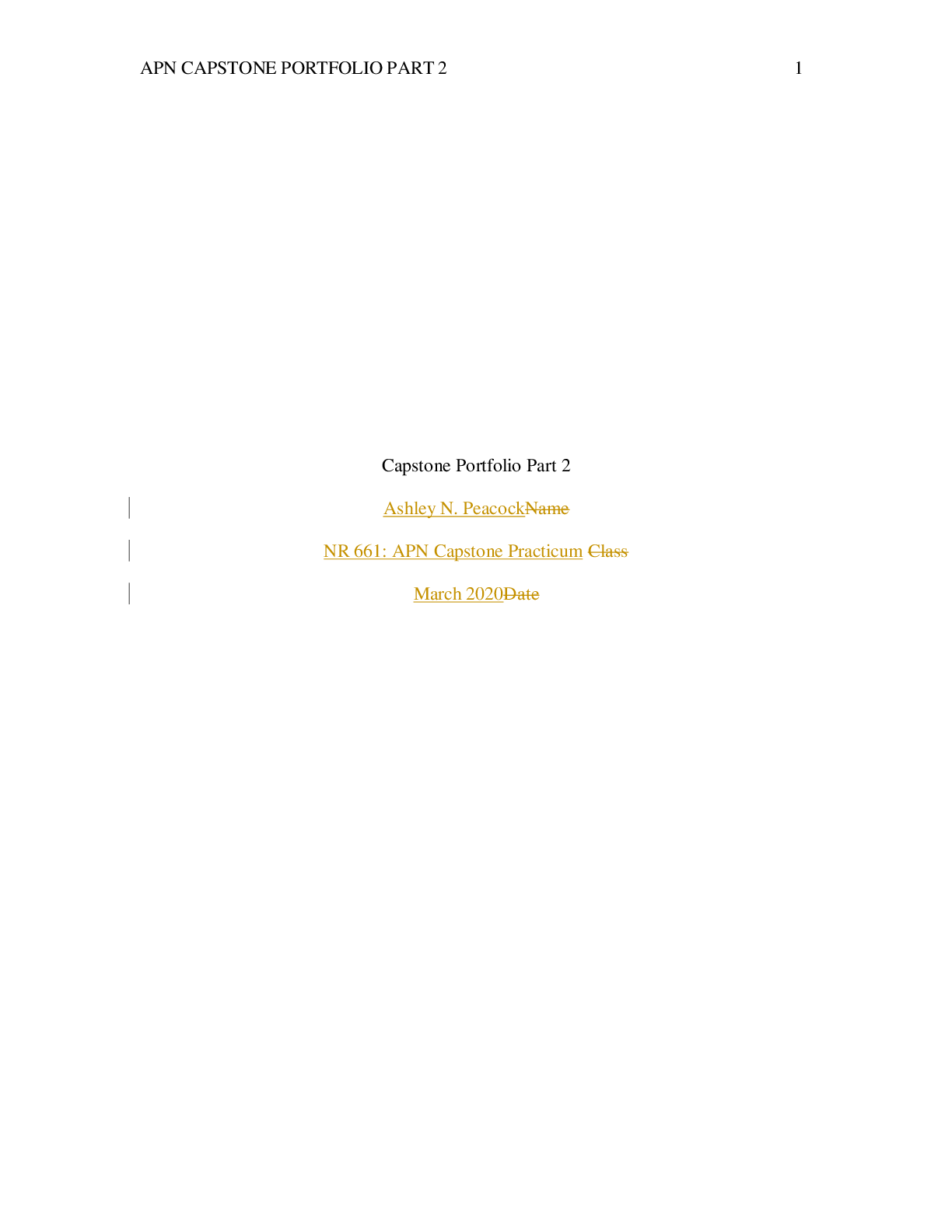
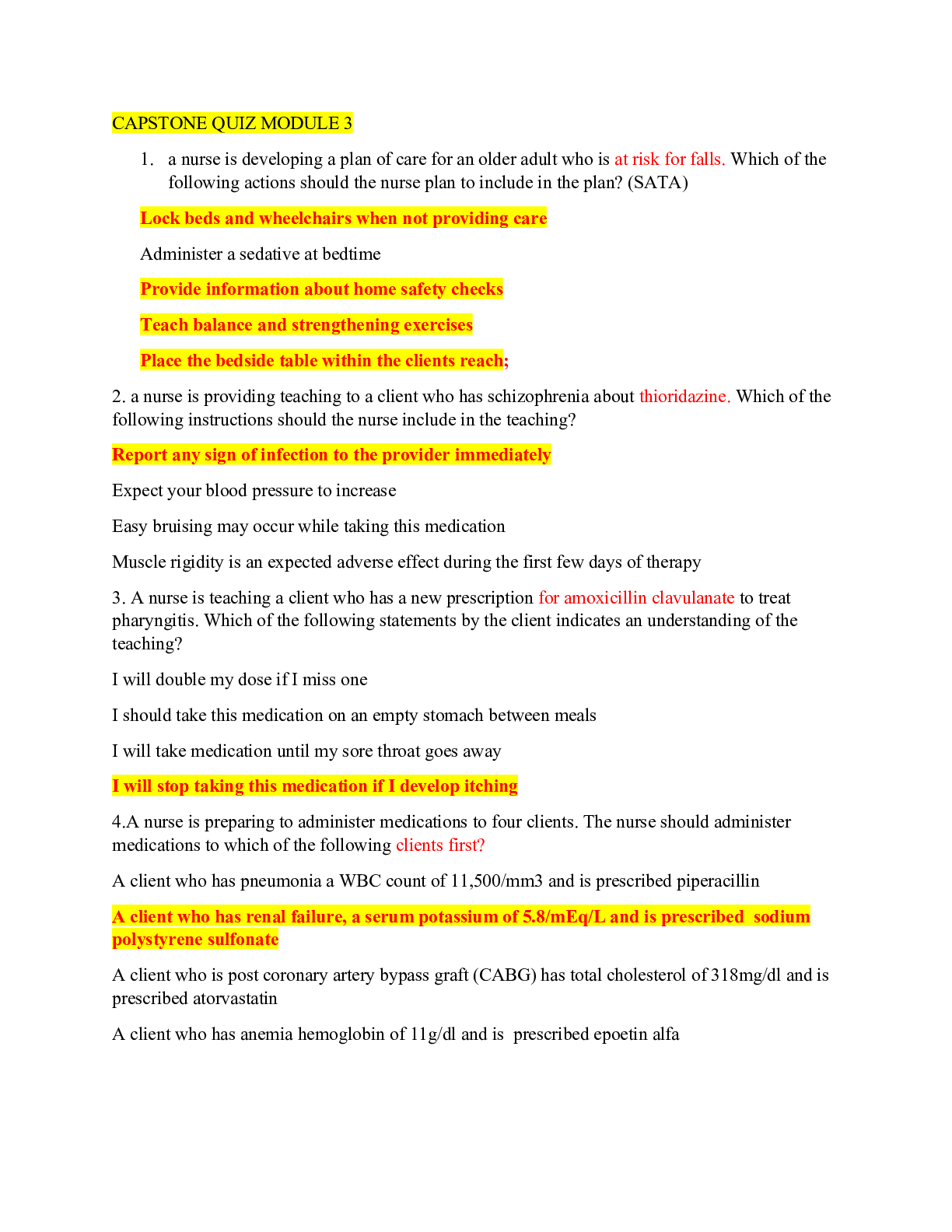
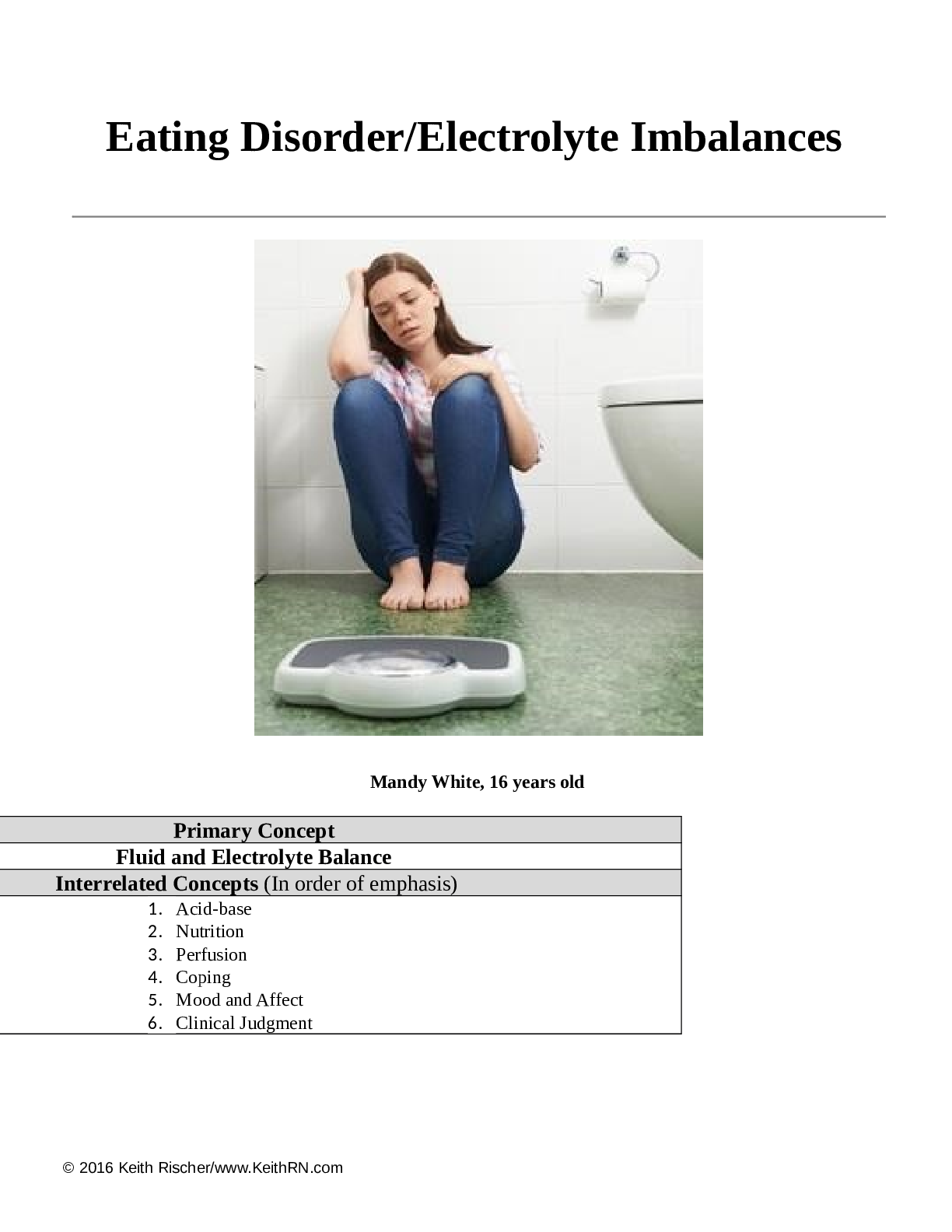
.png)
